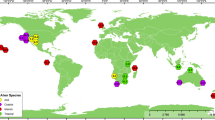Abstract
Our recent paper advocating adaptive management of invasive nonnative species (INS) in Kings Bay, Florida received detailed responses from both Daniel Simberloff, a prominent invasion biologist, and Mark Sagoff, a prominent critic of invasion biology. Simberloff offers several significant lines of criticism that compel detailed rebuttals, and, as such, most of this reply is dedicated to this purpose. Ultimately, we find it quite significant that Simberloff, despite his other stated objections to our paper, apparently agrees with our argument that proposals for alternative management of established INS (i.e., alternatives to minimization/eradication) should not be rejected on an a␣priori basis. We argue that more specific development and application of adaptive approaches toward INS management, whether in Kings Bay or other appropriate case studies, would be facilitated if ecosystem managers and invasion biologists follow Simberloff’s lead on this key point. While Sagoff largely shares (and, indeed, served as a primary source for developing) our general arguments that challenge common moral and scientific assumptions associated with invasion biology, he does question our suggestion that participatory adaptive management provides an appropriate framework for approaching environmental problems in which science and politics are inherently entangled. We attempt to answer this criticism through a brief sketch of what participatory adaptive management might look like for Kings Bay and how such an approach would differ from past management approaches.
Similar content being viewed by others
References
Bartodziej, W., & Leslie, A. J. (1998). The aquatic ecology and water quality of the St. Marks River, Wakulla County, Florida, with emphasis on the role of water hyacinth: 1989–1995 studies. Bureau of Invasive Plant Management, TSS (pp. 98–100). Tallahassee: Department of Environmental Protection.
Berardi, G. (2002). Commentary on the challenge to change: Participatory research and professional realities. Society and Natural Resources, 20, 847–852.
Bureau of Invasive Plant Management (2007). Status of the aquatic plant maintenance program in Florida waters: Annual report fiscal year 2005–2006. Tallahassee: Florida Department of Environmental Protection. http://www.dep.state.fl.us/lands/invaspec/2ndlevpgs/pdfs/aquatics05-06.pdf. Accessed Sep 2008.
Clavero, M., & García-Berthou, E. (2005). Invasive species are a leading cause of animal extinctions. Trends in Ecology and Evolution, 20, 110.
Evans, J. M., Wilkie, A. C., & Burkhardt, J. (2008). Adaptive management of nonnative species: moving beyond the “either-or” through experimental pluralism. Journal of Agricultural and Environmental Ethics, 21(6), 512–539.
Florida Statutes. (2008). Non-indigenous plant control, Chapter 369.22. http://www.leg.state.fl.us/statutes/index.cfm?App_mode=Display_Statute&URL=Ch0369/ch0369.htmAccessed Sep 2008.
Foster, J., & Sandberg, L. A. (2004). Friend or foe? Invasive species and public green space in Toronto. The Geographical Review, 94(2), 178–198.
Gurevitch, J., & Padilla, D. K. (2004). Are invasive species a major cause of extinctions? Trends in Ecology and Evolution, 19, 470–474.
Hershner, C., & Havens, K. J. (2008). Managing invasive aquatic plants in a changing system: Strategic consideration of ecosystem services. Conservation Biology, 22, 544–550.
Kanowski, J., Catterall, C. P., & Neilan, W. (2008). Potential value of weedy regrowth for rainforest restoration. Ecological Management and Restoration, 9, 88–99.
Krajick, K. (2005). Winnnig the war against island invaders. Science, 310(5753), 1410–1413.
Lockwood, J. A., & Latchininsky, A. V. (2008). Confessions of an entomological hit man. Conservation Magazine, 9, 15–19.
Norton, B. G. (2005). Sustainability: A philosophy of adaptive ecosystem management. Chicago: The University of Chicago Press.
Sagoff, M. (2005). Do non-native species threaten the natural environment? Journal of Agricultural and Environmental Ethics, 18, 215–236.
Sagoff, M. (2009). Environmental Harm: Political not biological. Journal of Agricultural and Environmental Ethics, 22(1). doi:10.1007/s10806-9127-4.
Sax, D. F., & Gaines, S. D. (2008). Species invasions and extinctions: The future of native biodiversity on islands. Proceedings of the National Academy of Sciences, 105(1), 11490–11497.
Schmitz, D. C., & Simberloff, D. (1997). Biological invasions: A growing threat. Issues in Science and Technology, 13(4), 33–40.
Shapiro, A. M. (2002). The California urban butterfly fauna is dependent on alien plants. Diversity and Distributions, 8, 31–40.
Simberloff, D. (2002). Today Tiritiri Matangi, tomorrow the world! Are we aiming too low in invasives control? In C. R. Veitch & M. N. Clout (Eds.), Turning the tide: The Eradication of Invasive Species (pp. 4–12). Gland, Switzerland and Cambridge, UK.: IUCN.
Simberloff, D. (2003). How much information on population biology is needed to manage introduced species? Conservation Biology, 17(1), 83–92.
Simberloff, D. (2009). Moving beyond strawmen and artificial dichotomies: Adaptive management when an endangered species uses an invasive one. Journal of Agricultural and Environmental Ethics, 22(1). doi:10.1007/s10806-008-9126-5.
SWFWMD (2004). Crystal River/Kings Bay technical summary. Brooksville: Southwest Florida Water Management District. http://www.bocc.citrus.fl.us/commdev/scc/cr_kingsbay_summary.pdf Accessed 1 Dec 2006.
Yokum, K. (2004). A victory for bass fishermen. BASS Times. http://sports.espn.go.com/outdoors/bassmaster/news/story?page=b_fea_bt_0411_fish_mng_victory Accessed 16 Sep 2008.
Author information
Authors and Affiliations
Corresponding author
Rights and permissions
About this article
Cite this article
Evans, J.M., Wilkie, A.C. & Burkhardt, J. Beneath the Straw: In Defense of Participatory Adaptive Management. J Agric Environ Ethics 22, 169–180 (2009). https://doi.org/10.1007/s10806-008-9135-4
Accepted:
Published:
Issue Date:
DOI: https://doi.org/10.1007/s10806-008-9135-4



